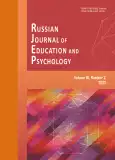Психологическая готовность к браку юношей и девушек в период студенчества
- Авторы: Маннанова Е.А.1, Никитина А.А.1
-
Учреждения:
- Мининский университет
- Выпуск: Том 16, № 2 (2025)
- Страницы: 434-451
- Раздел: Психологические исследования
- Статья опубликована: 30.04.2025
- URL: https://journals.rcsi.science/2658-4034/article/view/302888
- DOI: https://doi.org/10.12731/2658-4034-2025-16-2-744
- EDN: https://elibrary.ru/HRYOGG
- ID: 302888
Цитировать
Полный текст
Аннотация
Обоснование. Современное общество переживает трансформацию брачно-семейных ценностей, что проявляется в росте числа разводов, откладывании брака на более поздний возраст и распространении альтернативных форм отношений (сожительство, чайлдфри). Период студенчества является ключевым для формирования брачно-семейных установок, однако исследования показывают, что лишь 5% студентов демонстрируют достаточную готовность к семейной жизни. Несмотря на актуальность темы, работ, изучающих специфику психологической готовности к браку среди студентов, недостаточно. Это определяет необходимость проведения исследования для выявления уровня и особенностей такой готовности с учетом различий между юношами и девушками.
Цель. Выявить уровень и особенности психологической готовности к браку у студентов, а также проанализировать различия в брачно-семейных установках между юношами и девушками.
Материалы и методы. В исследовании приняли участие 60 студентов (30 девушек и 30 юношей) в возрасте 18–22 лет из Нижегородского государственного педагогического университета. Были использовании следующие экспериментальные методики: тест «Карта оценки готовности к семейной жизни» (И.Ф. Юнд), опросник «Мотивационная готовность к браку» (С.В. Жолудева), анкета «Нравственная готовность к браку» (Е.К. Погодина), анкета «Поиск спутника жизни» (автор С.С. Носков), авторская анкета, включающая вопросы об отношении к браку в период студенчества. Для статистической обработки данных использовался критерий Стьюдента для сравнения групп.
Результаты. Исследование показало, что большинство студентов (82%) имеют низкий уровень нравственной готовности к браку. Только 5% участников продемонстрировали достаточную готовность к семейной жизни, а 77% оказались на среднем (удовлетворительном) уровне. Девушки чаще, чем юноши, ориентированы на брак с конкретным человеком (t=4.78, p≤0.01) и проявляют более высокую нравственную готовность (t=5, p≤0.01). Юноши чаще склонны к «абстрактному браку» (52%), т.е. у них нет четких критериев выбора партнера. Эти данные отражают современные тенденции: молодежь откладывает брак, чаще выбирает альтернативные формы отношений и демонстрирует недостаточную осознанность в вопросах семейной жизни.
Ключевые слова
Об авторах
Елена Анатольевна Маннанова
Мининский университет
Автор, ответственный за переписку.
Email: emannanova1986@mail.ru
ORCID iD: 0009-0002-8644-9556
ResearcherId: MVV-9094-2025
кандидат психологических наук, доцент кафедры практической психологии
Россия, ул. Ульянова, 1, г. Нижний Новгород, 603000, Российская ФедерацияАлександра Александровна Никитина
Мининский университет
Email: Aleksa-nik08@mail.ru
ORCID iD: 0000-0003-3332-9163
ResearcherId: ABZ-4906-2022
кандидат психологических наук, доцент кафедры практической психологии
Россия, ул. Ульянова, 1, г. Нижний Новгород, 603000, Российская Федерация
Список литературы
- Жолудева, С. В. (2009). Психологическая готовность к браку на разных этапах периода взрослости (дис. … канд. психол. наук). Ростов-н/Д. 258 с. EDN: https://elibrary.ru/QEMJAX
- Калмыкова, Е. С. (1983). Психологические проблемы первых лет супружеской жизни. Вопросы психологии, (3), 90–100. EDN: https://elibrary.ru/SAHDLZ
- Карташова, Т. Е. (2011). Особенности брачно-семейных установок современной молодежи. Известия РГПУ им. А. И. Герцена, (129), 54–69. EDN: https://elibrary.ru/OFVEEB
- Косилова, А. Ф., & Коробейникова, Е. В. (2018). Современные демографические тенденции в России. Здоровье - основа человеческого потенциала: проблемы и пути их решения, 13(1), 80–86. EDN: https://elibrary.ru/YTUEQH
- Лопатюк, К. Е. (2021). Трансформация брачно-семейных отношений современной российской молодежи в условиях изменяющейся реальности. СГН, (1(5)), 258–266. EDN: https://elibrary.ru/ACMFWS
- Макарова, Е. Ю., & Цветкова, Н. А. (2022). Особенности психологической готовности к браку студенческой молодежи разной направленности образования. Проблемы современного образования, (6), 32–47. https://doi.org/10.31862/2218-8711-2022-6-32-47 EDN: https://elibrary.ru/JHDSNN
- Ночевнова, А. А., & Потапова, Е. В. (2024). Анализ демографической ситуации в Российской Федерации. Российский научный журнал "Телескоп: журнал социологических и маркетинговых исследований", (1(13)), 135–142. https://doi.org/10.24412/1994-3776-2024-1-135-142 EDN: https://elibrary.ru/AHGHPR
- Семенова-Полях, Г. Г., & Ванюхина, Н. В. (2017). Психологическая готовность молодежи к брачно-семейным отношениям: сравнительный аспект. АНИ: педагогика и психология, (1(18)), 306–309. EDN: https://elibrary.ru/YKOHEP
- Сизанов, А. Н. (2010). Подготовка подростков к семейной жизни. Новополоцк: Асвета. 108 с.
- Шапиро, Б. Ю. (1993). Половое "анти-воспитание" и его социально-психологические последствия. Народное образование, (7), 49–53.
- Goleman, D. (1997). Kecerdasan Emosional. Emotional Intelligence. Jakarta, ID: PT Gramedia Pustaka Utama.
- Holman, T. B., Larson, J. H., & Harmer, S. L. (1994). The Development and Predictive Validity of a new Premarital Assessment Instrument: the Preparation for Marriage Questionnaire. Family Relations, 43(1), 46–52. https://doi.org/10.2307/585141 EDN: https://elibrary.ru/BSMRCJ
- Sari, F., & Sunarti, E. (2013). Kesiapan Menikah Pada Dewasa Muda dan Pengaruhnya Terhadap Usia Menikah. Jurnal Ilmu Keluarga Dan Konsumen, 6(3), 143–153. https://doi.org/10.24156/jikk.2013.6.3.143
- Willoughby, B. J., Hall, S. S., & Luczak, H. P. (2015). Marital Paradigms: A Conceptual Framework for Marital Attitudes, Values, and Beliefs. Journal of Family Issues, 36(2), 188–211. https://doi.org/10.1177/0192513X13487677
- Carroll, J. S., Badger, S., Willoughby, B. J., Nelson, L. J., Madsen, S. D., & Barry, C. M. (2009). Ready or Not? Criteria for Marriage Readiness among Emerging Adults. Journal of Adolescent Research, 24(3), 349–375. https://doi.org/10.1177/0743558409334253 EDN: https://elibrary.ru/NTFCMD
Дополнительные файлы










